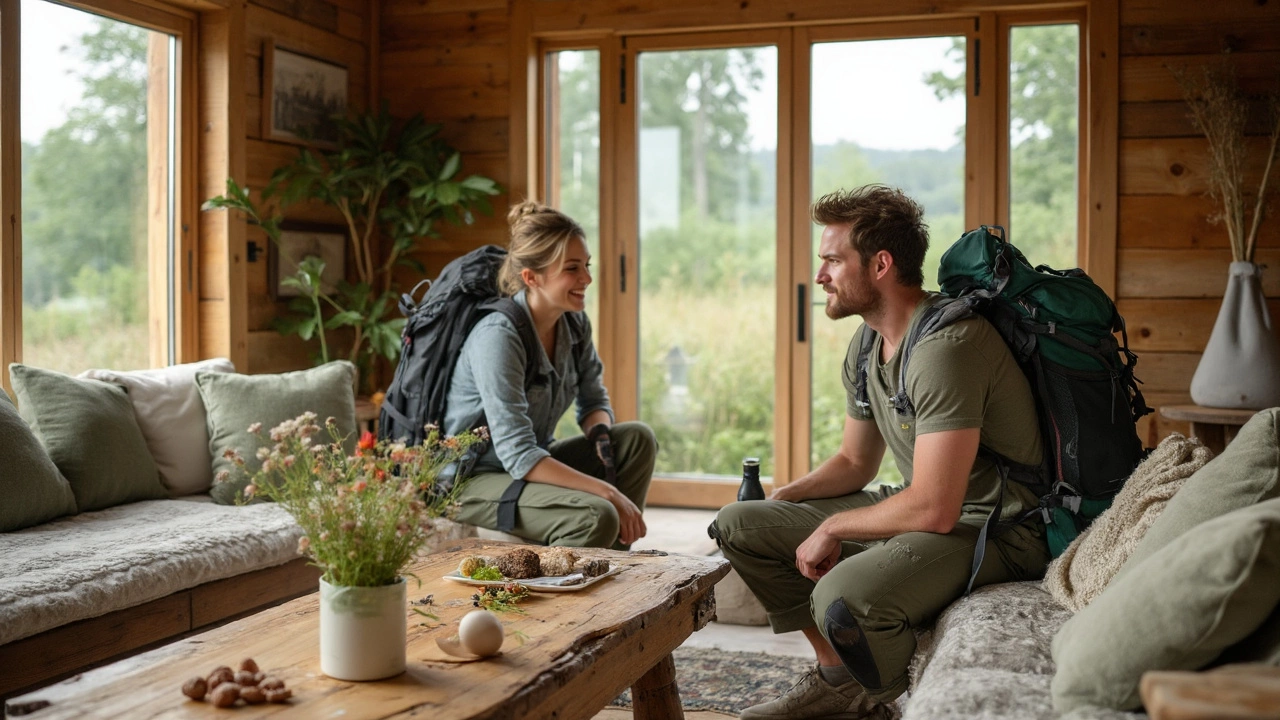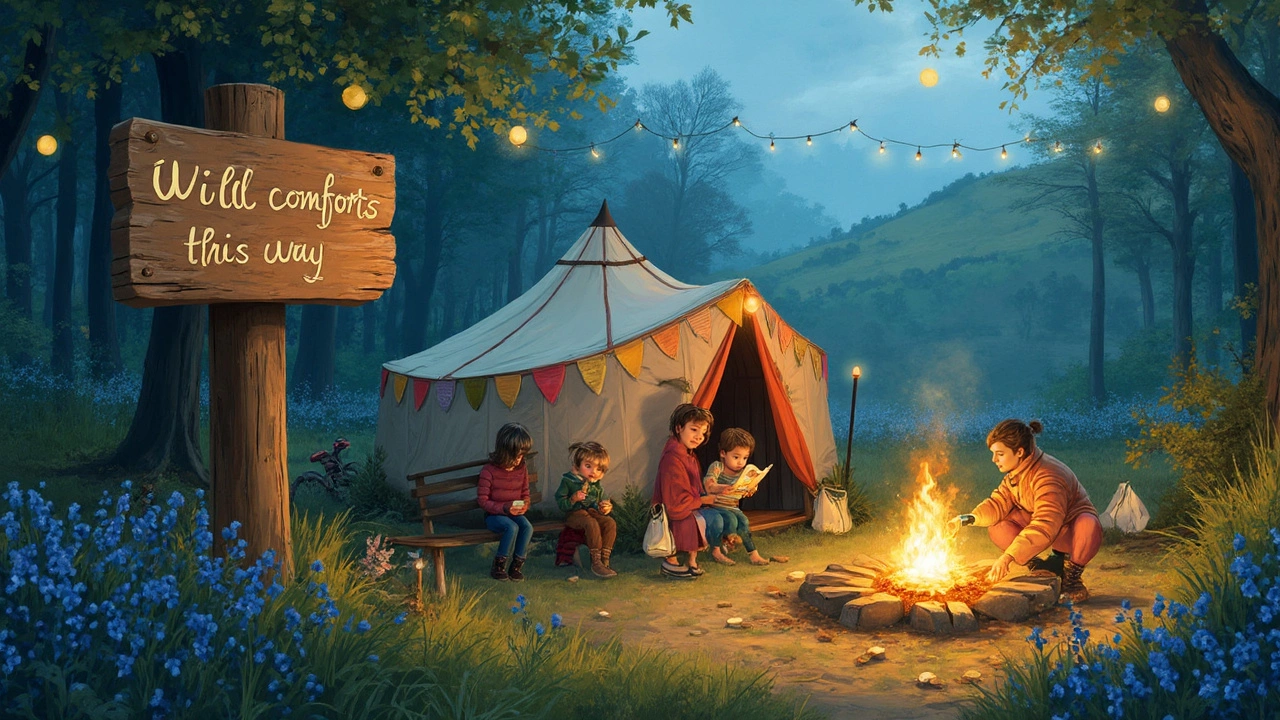So, you want to get out in nature but sleeping on a rock with sand in your socks isn’t really your thing? That’s where luxury camping, or glamping, comes in. Picture this: a real bed, a private bathroom, hot showers, maybe even underfloor heating—right in the middle of the woods. It’s camping, leveled up.
The best part? More and more of these setups are eco-friendly. No, you don’t have to give up comfort to be kind to the planet. Think solar-powered lighting, composting toilets, and cottages built with locally sourced wood. There are even places where rainwater is filtered for showers or gardens, so you’re not just a visitor—you’re making less impact too.
- What Counts as Luxury Camping?
- Why Eco-Friendly Cottages Lead the Way
- Creature Comforts Without the Footprint
- How to Tell if a Site Is Truly Green
- Tips for Your Own Luxury Eco Getaway
What Counts as Luxury Camping?
If you think luxury camping is just a bigger tent with more pillows, think again. The whole point of luxury camping—or glamping—is to flip the regular camping script. Here, you get all the best bits of the outdoors, minus the sore back and midnight bathroom runs through the bushes.
Luxury camping usually means proper beds with fresh sheets, real furniture that doesn’t wobble, and bathrooms that actually flush. Most spots offer heating for colder nights and sometimes extras like Wi-Fi, hot tubs, or even spa services. The walls aren’t always canvas, either—some of the most popular setups are eco-friendly cottages, treehouses, safari tents, or tiny homes tucked away in the wild.
Here’s what usually comes standard at a luxury camping stay:
- Real mattresses and cozy bedding—no squeaky sleeping bags.
- Private bathrooms, often with hot water and showers.
- Sturdy structures—think wood, bamboo, or upcycled materials, not just tent poles.
- Climate control, so no sweating or freezing inside.
- Outdoor seating to enjoy the view with a coffee or glass of wine.
The numbers back it up. According to a 2024 travel report, bookings for these kinds of stays jumped by 40% in the last two years, and guests consistently rate comfort and ease as their top reasons for choosing glamping over traditional camping.
You’re not roughing it or giving up what you love about a good vacation. Instead, luxury camping blends all the best things—nature, comfort, and a splash of style that makes you actually look forward to the trip.
Why Eco-Friendly Cottages Lead the Way
When you hear about eco-friendly cottages in the world of luxury camping, don’t just picture an expensive hut with a view. These places are built with real green practices that make a difference. For example, most high-end stays use local wood and stone so there’s less shipping, which cuts down on CO2. They also often have thick insulation, so you need way less energy to keep warm or cool, even if you’re deep in the forest or by a windy beach.
One thing I love? Many of these cottages tap into solar panels and even use natural ventilation instead of guzzling power from the grid. A growing number have adopted rainwater systems—meaning water for your shower or even drinking is collected right on site. That takes the load off local resources, especially in popular nature spots that already get stretched thin in busy seasons.
It’s not just about how these cottages are built, though. A lot also focus on the furniture and bedding inside, using certified organic cotton, recycled materials, and non-toxic cleaning products. Some also plant a tree for every booking or support community gardens nearby. If you want real numbers, a study by the Global Sustainable Tourism Council in 2023 showed that eco-accommodation can reduce energy use by up to 50% compared to standard hotels, especially when solar and passive designs are in play.
| Feature | Eco-Friendly Cottage | Traditional Cabin |
|---|---|---|
| Energy Use (avg) | Low – solar, passive | Medium/High – grid |
| Water System | Rainwater/greywater | Municipal, higher waste |
| Building Materials | Local, recycled | Often shipped, standard |
| Laundry/Cleaning | Non-toxic, low water | Conventional (higher impact) |
The message is simple: eco-friendly cottages in luxury camping make it possible to enjoy the wild, guilt-free. You’re not just treating yourself. You’re treating the planet better, too.

Creature Comforts Without the Footprint
Here’s the thing a lot of people don’t get about luxury camping: you can have the plush mattress, private deck, and Wi-Fi—and still be doing good by the planet. Most eco-friendly cottages aren’t just slapping a solar panel on the roof and calling it a day. They’re built smart, with the environment in mind from the ground up.
You’ll see details like triple-glazed windows to keep things warmer without cranking up the heat all night. Tons of places use reclaimed wood or recycled insulation so nothing goes to waste. You’ll find LED lighting nearly everywhere because it uses way less power. In fact, the latest figures from the International Energy Agency point out that LED bulbs use at least 75% less energy than old-school incandescents. Small switches like this add up fast if you’re running a whole campsite.
Let’s talk showers and toilets—boring, until you realize how much water actually gets saved. Compost toilets are a game changer. Most don’t even need plumbing, and they cut water waste down to almost zero. Rainwater-harvesting systems are pretty common now, and often, that water is filtered and piped right into your shower or sink. Some sites even post their own water use stats, like this example from a retreat near Cornwall:
| Feature | Annual Water Used (Liters) | Standard Camping (Liters) |
|---|---|---|
| Rainwater Showers | 8,000 | 15,000 |
| Composting Toilest | 1,200 | 8,000 |
But don’t worry—you won’t be roughing it. Soft blankets, real coffee, and sometimes even a breakfast basket made with veggies from the on-site garden are all on the menu. Think of it as trading the cheap plastic stuff for something that works just as well and fits seamlessly into the scenery.
If you care about the tech, some glamping spots even have solar-powered USB chargers and fast Wi-Fi routers using green energy. You can watch the stars, hear the owls, but still check in on your messages if you need to. It’s all about striking a balance between those creature comforts and smart, sustainable travel choices. Win-win, right?
How to Tell if a Site Is Truly Green
It’s easy for places to claim they’re eco-friendly, but how do you actually know if a luxury camping site or eco-friendly cottage is the real deal? There are real standards out there, not just market buzzwords. Here’s what to look for so you don’t fall for greenwashing.
- Certifications matter. Look for well-known badges like LEED, Green Key, or the Global Sustainable Tourism Council. If you see one of these, someone actually checked that the property uses real sustainable practices.
- Check the basics: Is the energy mostly solar or wind? Do they collect rainwater? Ask about composting toilets and water-saving showers. A proper green glamping site usually lists these features clearly on its site or booking page.
- Materials used. True eco-friendly cottages use local materials, not mass-produced stuff shipped halfway around the world. Many even show off their building process in blog posts or on social media.
- Local involvement. Are they supporting the local economy, hiring local, and helping with conservation? Real sustainable travel means everyone benefits—not just the owners.
One classic sign is transparency. If a site is open about its energy use, waste, and where it gets its materials, that’s a good sign. According to the International Ecotourism Society:
“Genuine ecotourism includes conservation, communities, and sustainable travel—if a lodge is really green, they measure and share their environmental footprint, not just pretty pictures.”
Also, take a peek at their stats if they share them—things like how much energy comes from renewables or how much waste gets recycled. Some places even add it up right on their booking page. Here’s a sample breakdown to look for:
| Eco Feature | % of Site Using |
|---|---|
| Solar Power | 90% |
| Composting Toilets | 85% |
| Recycled Building Materials | 70% |
| Rainwater Collection | 60% |
If you can’t find clear answers, don’t be shy—email and ask. The genuine places are usually happy to explain what goes on behind the scenes. When I booked my last trip with Lachlan, the host even sent me a little info sheet all about their solar setup and reforestation work. Real green sites love sharing what makes them different.

Tips for Your Own Luxury Eco Getaway
Ready to jump into luxury camping but want to keep your environmental impact low? Here’s how to do it right without giving up comfort.
- Check the details. Before you book any eco-friendly cottage or glamping site, ask about how they handle energy, waste, and water. The good places will brag about solar panels, rainwater collection, or composting toilets right on their websites.
- Book local, eat local. Places that partner with nearby farms or offer local food baskets are greener. This helps the planet and gives you a fresher, tastier experience. Lachlan still talks about that honey from a tiny farm next to our treehouse stay!
- Pack smarter, not heavier. Even at a luxury spot, bring refillable water bottles, eco soaps, and cloth bags. Lots of places have recycling but being prepared saves you hassle and helps keep extra plastics away from beautiful landscapes.
- Look for honest certifications. Programs like Green Key or EarthCheck actually inspect sites for real eco standards. Don't settle for fake “green” claims. Real certifications mean the place actually does the work.
- Respect nature—seriously. Stay on paths, don’t mess with the wildlife, and keep your phone’s flashlight off at night if there’s a stargazing spot. The whole point of eco-friendly cottages is to blend into the world around you, not trample it.
Curious about what features matter most to travelers looking for sustainable travel in nature escapes? Here’s a snapshot from a 2024 survey of 2,000 eco-campers:
| Most Wanted Eco Feature | Percent of Campers |
|---|---|
| Solar Power or Green Energy | 67% |
| Local & Organic Food | 58% |
| Recycling and Composting | 54% |
| Natural or Chemical-Free Toiletries | 42% |
If you look for these basics—and maybe a comfy chair with a killer view—you’ll have the best of glamping and a clear conscience too.
